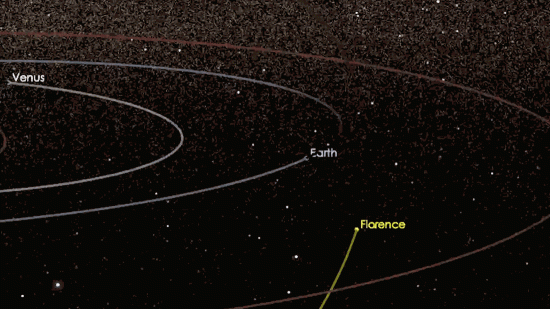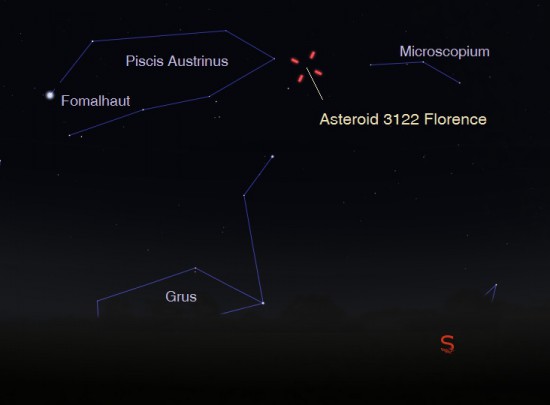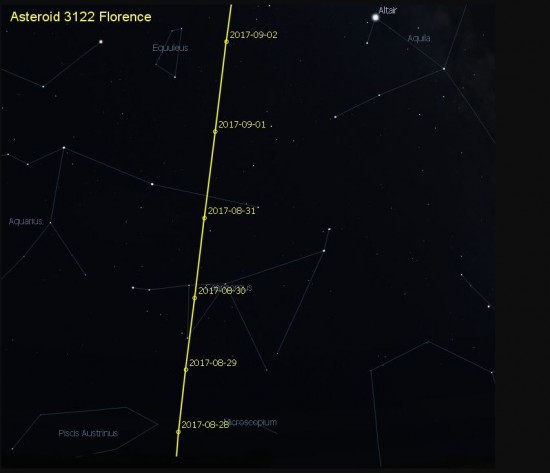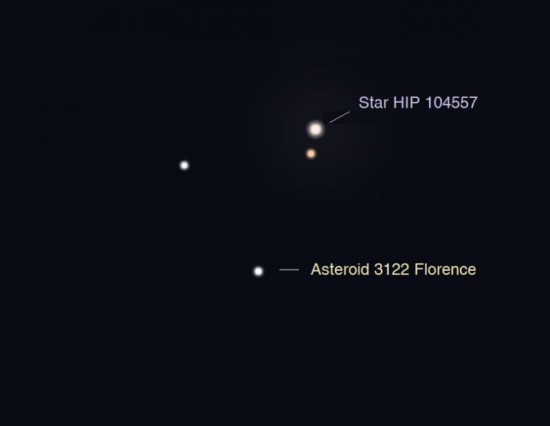Giant Asteroid Florence Visible with Binoculars

Click for full size image that shows animated flightpath of Asteroid Florence. Credit: NASA/JPL-Caltech
Asteroid Florence will pass near to earth at the end of August early Sept 2017 and many be Visible with Binoculars – details of where and where to look:
Discovered in 1981 and named in honor of Florence Nightingale, Asteroid Florence will get close enough to earth in late August and early September where according to the Center for Near Earth Object Studies (CNEOS), it will probably brighten to about the 9th magnitude and thus make it easily visible using a small telescope and possibly even with a good set of Astronomy binoculars.
Near-Earth Object
A Near-Earth Object (NEO) is an asteroid or comet with an orbital path that brings it close to earth and Florence is just that because it will close to within around 7 million kilometers (4.4 million miles) of our planet.
and as NASA’s Paul Chodas, manager of CNEOS point out, at 2.7 miles (4.4 kilometers) across “Florence is the largest asteroid to pass by our planet this close since the NASA program to detect and track near-Earth asteroids began.”
This size and it’s close proximity means that Asteroid 3122 Florence big enough to be seen in small telescopes, and maybe even in binoculars, as a small, very slow-moving “star.” Asteroid 1981 ET3 – also known as 3122 Florence – is a huge space rock at least 2.7 miles (4.35 km) in diameter. According to Paul Chodas at the Center for Near Earth Object Studies:
When & Where to Look
I managed to get the following information written by Eddie Irizarry from the (Astronomical Society of the Caribbean) and published on the EarthSky Website:
Asteroid 3122 Florence will be the nearest to Earth at about 8:06am EDT (2:06pm CEST) on September 1st, 2017, but if you have a telescope or binoculars for astronomy, you can try a few nights before then:
On August 27, th asteroid Florence will be in the constellation of Piscis Austrinus at about 19° above the southern horizon as seen from central U.S.

Asteroid 3122 Florence on August 27 at 11:50 pm CDT as seen from central U.S. Credit: Eddie Irizarry
Then Late at night on August 29th, 3122 Florence goes into Capricornus and reaches an elevation of 33° as seen from Kansas.
Also on 11:40 pm CDT on August 30 and if you have a have a automatic computerized telescope, then set it to star HIP 104557 or to RA 21h11m57.45s / DEC -9º23’33.6″and you should see the asteroid making a slowly changing triangle with these stars (see illustration below)
Even though Florence will be traveling at 48,708 km/h (30,266 mph), the relatively far distance from us will mean that it’s movement will not be obvious. Indeed you will need about 5 to 10 minutes to notice the movement compared to the stars around it.

 Article | Posted by Best Binocular Reviews
Article | Posted by Best Binocular Reviews 


 Categories:
Categories:  Tags:
Tags: 
